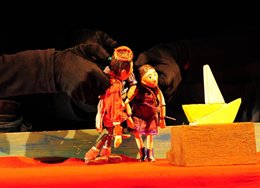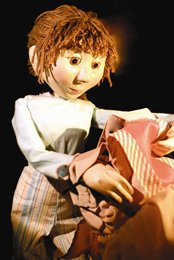The power of the imagination to create magic or ‘draíocht’ is central to Branar’s two recent works of puppet theatre, Clann Lir and Mise, Scéal Cailín. As the puppeteers explained before each show began, music is central to conjuring the enchanted worlds that Branar’s characters inhabit. Original compositions inspired by traditional Irish melodies helped to captivate each audience, with gentle harp notes adding to each piece a particularly magical quality. These works are without dialogue. However, Clann Lir’s puppeteers (Keily and Ní Chunaigh) narrated the action through an accessible and instructive use of the Irish language, giving the English translation for more difficult words.
Clann Lir is Branar’s re-imagining of the well-known folktale concerning a father’s love for his children. Here, Lir is the father of a girl and a boy, Fionnuala and Conn. When his wife dies, the devastated Lir decides to marry Aoife so that his children will have a stepmother. However, jealous of these children who are loved so dearly by her husband, Aoife turns Fionnuala and Conn into swans. The spell can be broken only when the gap between the two highest mountains is bridged. While it departs somewhat from the original, Branar’s retelling is also peppered with chilling and poignant moments. Yet, this version offers a much more heartening finale than the myth which lies at its source.
 The production achieved intricate illusions through an adept use of simple props, lighting and sound. Marcus Quinlan’s set was composed of two step-ladders and a connecting plank. This construction functioned variously as Lir’s castle and the pair of mountains on which the plot hinges. The team produced a variety of effects through a resourceful use of light: Quinlan spot-lit significant portions of the stage and the performers made sporadic use of torches. The backlit castle’s windows (the spaces between the ladders’ steps) became an ideal forum for shadow puppetry. This worked particularly well for the tragic scene in which the children morph slowly into birds. In addition, evocative music helped to set the different tones and moods of the piece. Michael Chang used a range of instruments to accompany harpist Freda Nic Giolla Chathain throughout, as well to generate realistic sound effects such as wind and the cawing of gulls.
The production achieved intricate illusions through an adept use of simple props, lighting and sound. Marcus Quinlan’s set was composed of two step-ladders and a connecting plank. This construction functioned variously as Lir’s castle and the pair of mountains on which the plot hinges. The team produced a variety of effects through a resourceful use of light: Quinlan spot-lit significant portions of the stage and the performers made sporadic use of torches. The backlit castle’s windows (the spaces between the ladders’ steps) became an ideal forum for shadow puppetry. This worked particularly well for the tragic scene in which the children morph slowly into birds. In addition, evocative music helped to set the different tones and moods of the piece. Michael Chang used a range of instruments to accompany harpist Freda Nic Giolla Chathain throughout, as well to generate realistic sound effects such as wind and the cawing of gulls.
Clann Lir’s young viewers, and the adults in the theatre, were enthralled throughout the show. After the show, Keily and Ní Chunaigh made themselves available for a Q&A session with the children in which the performers allowed the viewers to consider how the production might have achieved certain effects, such as colour in the shadow puppetry. They then gave instructions as to how such representations are crafted. Rather than reversing the successful illusionism of the piece, this worked to kindle the audience’s creativity.
The combined efforts and versatility of Branar’s team deserve high praise for Clann Lir, an incredibly beautiful and captivating production.  Aesthetically, Mise, Scéal Cailín was also a commendable achievement, although not quite as gripping. A slower-paced, more dreamlike piece, it might perhaps be better suited to a younger audience.
Aesthetically, Mise, Scéal Cailín was also a commendable achievement, although not quite as gripping. A slower-paced, more dreamlike piece, it might perhaps be better suited to a younger audience.
Portraying a little girl who cannot sleep and the adventures she has trying, the action here is fragmented. As the little girl becomes distracted by the magic of her own imagination, mundane objects become props in her fantasies and, eventually, take on a life of their own. The set conveyed a typical little girl’s bedroom. This ordinary room gradually started to swirl into life as previously inanimate objects began to pulsate with energy. One highlight of the show depicted a playful, charismatic and clumsy rug who teaches the girl how to dance. Through effective puppetry, the rug became vividly anthropomorphised. These scenes contributed to the slapstick humour of the piece. Gentle harp notes, a softening of Quinlan’s lighting and stylised puppetry enhanced the production’s more dreamlike moments, while abstract animation was projected onto a screen behind the set for added ambience.
Using dolls finely-crafted by Suse Reibisch, the puppetry in Clann Lir and Mise, Scéal Cailín was absorbing, conjuring a vast range of dispositions and emotions. Clann Lir’s swans were particularly effective; their delicate, beaded necks allowed for flexibility whilst also evoking frailty and grace. Both Clann Lir and Mise, Scéal Cailín employ Irish music and language to promote and embrace Irish culture. Ultimately, these productions showcase Branar’s capacity to instruct, stimulate and inspire young audiences.
Siobhán O’Gorman is currently completing a doctoral research project on contemporary theatre at the National University of Ireland, Galway.